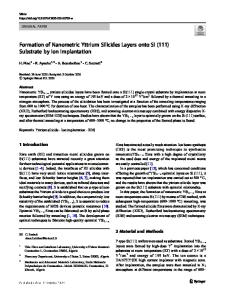Kinetics of formation of silicides: A review
- PDF / 1,899,109 Bytes
- 17 Pages / 595.44 x 841.68 pts Page_size
- 88 Downloads / 361 Views
Kinetics of formation of silicides: A review F. M. d'Heurle and P. Gas"' IBM Research Center, P. O. Box 218, Yorktown Heights, New York 10598 (Received 30 September 1985; accepted 3 January 1986) The kinetics of silicide growth are classified into three different categories: (a) diffusion controlled, (b) nucleation controlled, (c) others (reaction rate controlled). These are analyzed with the aim of understanding both the phenomenology of growth and the specific atomic mechanisms of phase formation. Diffusion-controlled growth is discussed with respect to the Nernst-Einstein equation. Stress relaxation is considered as a possible cause of reaction-rate control. The relative merits of two different types of marker experiments are compared. A few silicides are discussed in terms of what can be inferred about diffusion mechanisms. The competition between reaction-rate and diffusion control phenomena is shown to have specific effects on the sequence of phase formation; it is also related to the formation of some amorphous compounds. Reactions between silicon and alloyed metal films are used to illustrate the respective influences of mobility and driving force factors on the kinetics of silicide growth; they can also be used to underline the dominance of nucleation over diffusion in some silicide formation processes.
I. INTRODUCTION Silicides can be used as protective coatings against high-temperature oxidation of metals such as molybdenum and tungsten. For this purpose the desired silicide layer1"3 can be prepared by various means, for example, gas-metal reactions in which silane is decomposed at elevated temperature over the metallic object to be protected. There has been at least one reference to the application of such a reaction for electronic devices.4 In this paper we will consider only the kinetics of solid-state reactions in which a metallic thin film, deposited either through vacuum evaporation, sputtering, or other means, is caused to react with a silicon substrate, generally a single crystal, by heat treatment. The literature includes references to the "formation" of silicides during the annealing of amorphous films containing both metal and silicon produced by some technique of codeposition over, for example, SiO2. This should rightly be called crystallization; it involves no long-range atomic diffusion, and will not be considered here. Three classes of reaction kinetics will be described: (a) diffusion, (b) nucleation, and a third class (c) where one will analyze reactions that do not fall neatly in either one of the first two categories. The question of which atomic species, metal or silicon, contributes most to the formation of the new phase will be discussed. Space being limited, the reader interested in greater details is invited to turn his attention to a relatively recent and extremely complete survey5 of the literature on silicides. In electronics one is concerned mainly with reactions that involve limited amounts of metal and, for our a)
Permanent address: Laboratoire de Metallurgie, U.A. 443, Fa
Data Loading...







